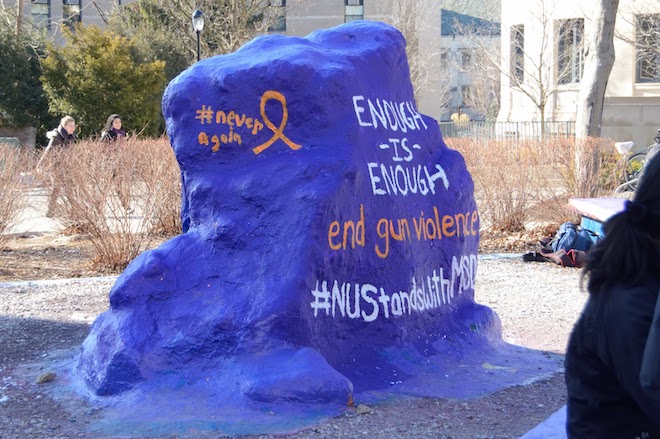
Students painted the Rock on National Walkout Day earlier this year.
Photo by Margaret Creighton / North by Northwestern
One month after the shooting at Marjory Stoneman Douglas High School, hundreds of Northwestern community members joined thousands of schools across the country in a nationwide walkout in support of gun reform. Just hours after students gathered for the protest, they hid in supply closets and classrooms to escape a reported shooter on Northwestern's campus.
The shooter turned out to be a hoax, but students said the fear they felt was real.
At the same time, while Northwestern students walked-out and locked-down, it was a typical day in Chicago: On March 14, 2018, four people were shot in the city, all of them under the age of 25. Last year alone, 3,457 people were shot in Chicago. The city saw 664 murders plus seven people killed in 2017 by on-duty Chicago Police officers, according to data compiled by the Chicago Sun-Times.
According to a working paper co-authored by Kellogg professor Craig Garthwaite, Chicago’s high rates of gun violence may have less to do with gun policy and more to do with a cultural phenomenon: the crack cocaine epidemic. Sociologists have widely accepted the crack cocaine theory as the genesis for America’s gun problem for years. However, as the boom of crack cocaine receded, the traditional theory could no longer fully explain the persisting gun violence in cities like Chicago. Garthwaite’s paper dives deeper into the theory to explain crack markets’ role in today’s widespread gun violence in big cities.
“Organized crack markets receded for a variety of reasons,” Garthwaite said. “But you’re still left with all these guns in circulation, and a long-running impact of the guns affecting violence. After crack markets [receded], people – particularly young black males – were far more likely to carry guns, which means that regular altercations that might have been just normal violence before escalated to lethality.”
In the working paper, Garthwaite and his coauthors, economics professors William Evans of Notre Dame and Timothy Moore of Purdue, wrote that the rush of firearms into the U.S. can be explained by crack cocaine markets in the 1980s and '90s. The authors write that the increase in gun-related domestic violence murders over the sixteen years after crack markets arrived shows that the increased availability of guns changed the way people settled disputes and therefore increased the murder rate.
“At a high level, to have a murder happen, what you need is two things: First, you need an altercation that’s going to escalate to violence, and second, you need a means for that violence to become lethal, which in this case is guns,” Garthwaite said.
The availability of firearms in America is widespread. According to the global Small Arms Survey, there are more than 393 million civilian-owned firearms in the U.S. – that’s enough for every person living in the U.S. to own one and still have 67 million guns left over.
Despite the evidence pointing towards America’s gun epidemic being a “gun problem,” Americans still argue that it’s a “people problem.” At a press conference this February, National Rifle Association executive vice president Wayne LaPierre said, “If a man with a family history of social anxiety and isolation decides to kill 12 people with a rifle...that’s not the gun’s fault. The fact is that mentally unstable individuals are going to lash out, and if it’s not with a gun, it would just be through other, far less efficient and deadly means.”
However, mass shootings by people with serious mental illness represent just 1 percent of all gun homicides each year. Garthwaite and his co-authors showed, through extensive analysis, that when more guns are available, more shootings occur. The authors wrote that even 16 years after the emergence of crack markets, murder rates for young black males were 70 percent higher than they would have been had they followed the trends of older black males.
Even with all the statistics and papers available, Garthwaite said gun violence is a topic that many people don't think about unless it has immediately affected them. Despite the widespread use of firearms and extreme violence in some parts of Chicago, it can be difficult for students at a place like Northwestern to come to terms with the reality that some Chicagoans face every day.
“Gun violence is not always fully acknowledged at Northwestern,” said Communications sophomore Valen-Marie Santos, an instrumental member of the team of students who planned Northwestern’s National Walkout for Gun Violence in March. “[The walkout] was kind of born out of this frustration that nobody on campus was really talking about what happened. We knew we needed to have that conversation on campus and that Northwestern shouldn't be silent, especially with Chicago so close to home.”
And Chicago has persistently high levels of violence. So far this year, 510 people have been shot in the city. Young Black and Brown males are carrying the burden of the crack cocaine epidemic, and they are paying for it with their lives. Santos believes that this should be more front-of-mind for all Northwestern students.
“Northwestern can become this bubble where you live here and things happen outside of it, but it seems fine because it doesn't directly affect you,” Santos said. “As young people – as people just figuring out our place in the world – we should be learning to care about these things.”